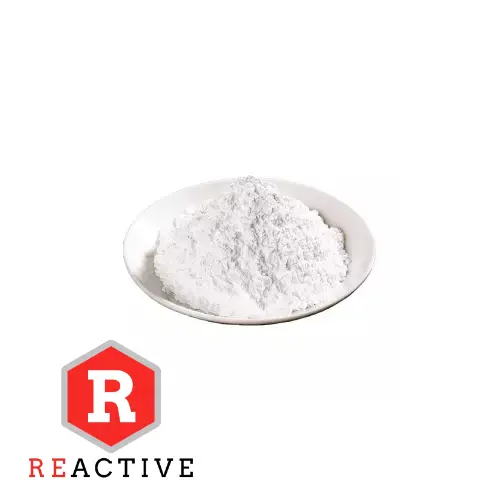Abstract: Nickel and cobalt were selectively precipitated and enriched from Mn, Mg containing sulfate medium with active magnesium oxide. The results show that the optimum precipitation conditions include twice of theoretical dosage of active magnesium oxide, reaction time of 6 h, and precipitation temperature of 25 ℃. The precipitation rate of nickel and cobalt is 97.96% and 96.43% respectively. The content of nickel, cobalt, manganese and magnesium oxide in precipitate is 8.51%, 13.05%, 2.29%, and 4.97% respectively. The average static-state free settling velocity of slurry is 180 mm/min with the dosage of flocculant AN905 of 0.2 g/m3.
Key words: active magnesium oxide; precipitation; nickeliferous laterite; copper & cobalt oxide ore; nickel and cobalt selective precipitation
When laterite nickel ore or copper-cobalt oxide ore is acid leached [1-10], nickel, cobalt, manganese and magnesium usually coexist in the solution during the solution purification and separation process. The traditional methods for enriching and separating nickel and cobalt in this solution are sulfide precipitation and neutralization precipitation [8-9]. Since the sulfide precipitation method uses alkaline precipitants such as H2S, NaHS, Na2S, NH4HS and sodium disulfide (SDD), the precipitation pH needs to be controlled during the precipitation process. If the pH is too low, H2S gas will be generated, affecting the operating environment. However, when the pH is too high, the content of manganese and magnesium in the precipitate is too high, which will affect the subsequent purification and separation of valuable metals. In addition, the operating conditions are harsh and not conducive to production [11-14]. In the neutralization precipitation method, the traditional neutralizer usually uses Na2CO3 or NaOH with strong alkalinity. In the neutralization precipitation process, local over-alkalinity usually occurs, resulting in high content of manganese and magnesium in the enriched product. In addition, hydroxide colloid is formed in the precipitation process, which is not conducive to the liquid-solid separation of the precipitate [15-16], and it also introduces impurity ions such as Na+ and NH4+ into the post-precipitation liquid, which makes the treatment of the post-precipitation liquid difficult. In view of the above problems of sulfide precipitation and traditional neutralization precipitation method, this paper uses active magnesium oxide as a precipitant to selectively precipitate nickel and cobalt from sulfuric acid medium containing manganese and magnesium.
1 Test raw materials and methods
The solution of sulfuric acid leaching of a low-grade oxidized copper and cobalt ore-extraction recovery of copper-oxidation and neutralization of iron and aluminum removal pH=4.5 was used as the raw material, and the main metal ions were composed of (g/L): Ni 0.22, Co 0.36, Mn 4.15, and Mg 3.45.The precipitant was activated magnesium oxide, containing MgO 94.48%.
According to nickel, cobalt, manganese, magnesium, four metal ions in aqueous solution at 25 ℃ potential-pH equilibrium diagram, when the initial mass concentration of nickel in the solution of 0.58 g / L, the start of precipitation pH 7.1, the basic precipitation of the complete pH 8.1; when the initial mass concentration of cobalt in the solution of 0.59 g / L, the start of the precipitation of the pH 7.2, the basic precipitation of the complete pH 8.2; when the initial mass concentration of cobalt in the solution of 0.59 g / L, the start of precipitation of 7.2, the basic precipitation of complete the pH of 8.2; when the initial mass concentration of manganese in the solution was 5.5 g/L, the pH of the beginning of precipitation was about 8.2, and the pH of the basic precipitation completely was 9.8; when the initial mass concentration of magnesium in the solution was 2.4 g/L, the pH of the beginning of precipitation was about 9.5 [17-19]. Therefore, according to the composition of the raw material solution for the test, the use of neutralization and precipitation can be used to initially separate nickel, cobalt and manganese and magnesium in the solution.
Test method: take a certain volume of solution, heat it to a set temperature, slowly add a certain multiple of the theoretical amount of activated magnesium oxide powder under strong stirring, and monitor the pH of the solution. after a certain time of reaction, filter it, take the filtrate to analyze the content of manganese, nickel and cobalt in the solution, and the filter cake is washed with water and then dried, and analyze the content of nickel, cobalt, manganese and magnesium in the precipitation.
2 Results and Discussion
2.1 Effect of active magnesium oxide addition amount
Fixed conditions: reaction time 4 h, reaction temperature 60 ℃, direct addition of magnesium oxide powder, control the addition rate by controlling the solution pH < 8.0, the effect of the addition of active magnesium oxide powder on precipitation is shown in Figure 1.
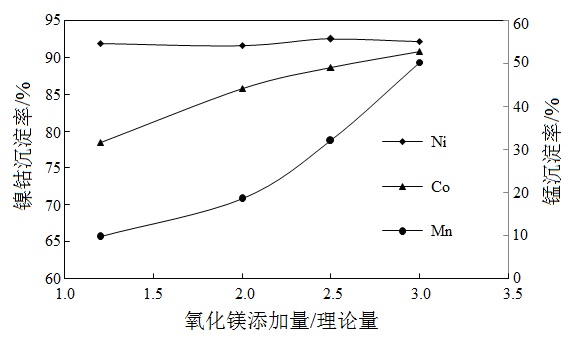
Figure 1 shows that the manganese precipitation rate in the solution increased significantly by increasing the addition amount of active magnesium oxide. In the magnesium oxide additive amount for the theoretical amount of 3 times, 60 ℃ conditions, nickel, cobalt precipitation rate is very high, but manganese precipitation rate is also as high as 50.23%. Therefore, the amount of magnesium oxide added in 2 times the theoretical amount can be controlled, the conditions, nickel, cobalt precipitation rate of 91.61% and 85.72%, respectively, manganese precipitation rate of 18.49%, but still on the high side, but also need to carry out other conditions to optimize.
2.2 The effect of active magnesium oxide adding method
In the test found that the active magnesium oxide powder added to the solution, the first is the formation of a small group floating on the liquid surface, stirring for a period of time before slowly diffused into the solution, which may affect the utilization efficiency of magnesium oxide and cause the solution of local over-alkali phenomenon. Usually the addition of neutralizing agent is first slurry and then add, so as to avoid the powder neutralizing agent due to the role of surface tension leads to the neutralizing agent diffusion speed reduction and localized over-alkaline and lead to precipitates wrapped in the neutralizing agent, reduce the utilization rate of the neutralizing agent and other issues. The following is a test comparison of the two forms of adding active magnesium oxide slurry and powder.
Test conditions: reaction time 4 h, temperature 60 ℃, add 2 times the theoretical amount of active magnesium oxide. When the active magnesium oxide in powder form to add, after precipitation liquid composition (g / L): Ni 0.017, Co 0.051, Mn 3.38, liquid meter precipitation rate (%): Ni 92.37, Co 85.72, Mn 18.49; when the active magnesium oxide slurry to add, after precipitation liquid composition (g / L): Ni 0.007, Co 0.017, Mn 3.54, liquid meter precipitation rate (%): Ni 96.81, Co 95.23, Mn 14.83. It can be seen that the addition of activated magnesium oxide after slurries, nickel, cobalt precipitation rate has a greater increase, this is due to the slurries after the activated magnesium oxide in the reaction process of rapid diffusion of the results. Adding 2 times the theoretical amount of magnesium oxide after slurring, the precipitation rate of nickel and cobalt liquid meter was 96.81% and 95.23%, respectively.
2.3 Effect of temperature
Fixed conditions: 2 times the theoretical amount of magnesium oxide was added after slurrying and the reaction time was 4 h. The results of the effect of temperature on precipitation are shown in Fig. 2.
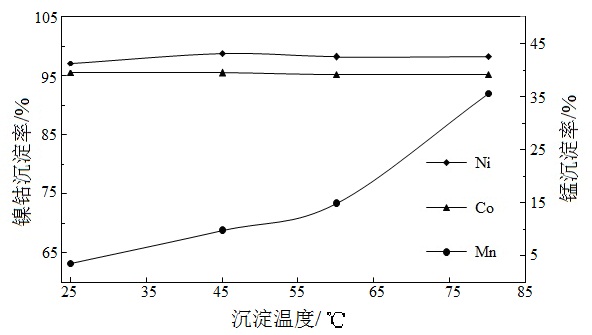
As can be seen from Fig. 2, the manganese precipitation rate in the solution increases rapidly with the increase in temperature, but the temperature has little effect on the precipitation rate of nickel and cobalt, so it is sufficient to use 25 ℃ room temperature precipitation.
2.4 Effect of reaction time
Fixed conditions: add 2 times the theoretical amount of magnesium oxide after slurrying, precipitation temperature 25 ℃, the results of different reaction residence time are shown in Figure 3.
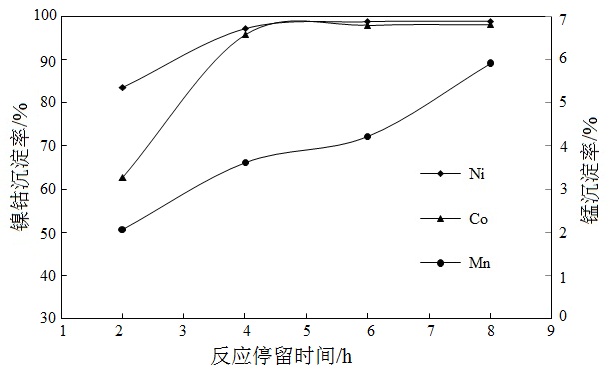
Figure 3 shows that the time for complete precipitation of nickel and cobalt is about 4 h and 6 h, respectively, and the manganese precipitation rate increases with the increase of precipitation time. For comprehensive consideration, the reaction residence time was chosen to be 6 h.
2.5 Comprehensive condition test
Comprehensive test results of the above conditions, the best conditions for selective precipitation of nickel and cobalt from sulfate media containing manganese and magnesium solutions are as follows: add 2 times the theoretical amount of activated magnesium oxide after slurrying, precipitation residence time of 6 h, precipitation temperature of 25 ℃. When the solution composition is (g/L): Ni 0.22, Co 0.36, Mn 1.15, using the above optimal conditions for the integrated conditions test, the precipitation composition (%): Ni 8.51, Co 13.05, Mn 2.29, MgO 4.97. Nickel, cobalt, manganese, the liquid meter precipitation rate of 97.96%, 96.43%, 4.22%, respectively.
The results of the comprehensive condition test show that the content of manganese and magnesium in the precipitation enrichment is low, which is favorable for the subsequent acid dissolution-purification-refining process of nickel and cobalt.
2.6 Sedimentation test
Because the concentration of precipitated nickel and cobalt slurry is very low (0.28%), it is inconvenient to use direct filtration for liquid-solid separation, and it must be thickened before filtration. The following comprehensive test precipitated nickel, cobalt slurry is taken for static sedimentation test to investigate the thickening performance of the slurry.
Nickel, cobalt precipitation true density of 2.72 g/cm3, precipitation of nickel, cobalt after the liquid density of 1.01 g/cm3.
Static settlement test method: take 1 000 mL of comprehensive test nickel, cobalt precipitation slurry, pour it into the static concentration settlement tester, take 0.2 mL of AN905 flocculant with mass concentration of 0.1% to add into the slurry, and then mix it sufficiently to carry out the settlement test, record the height of the solid material settling at different time points, and calculate the average settling speed, and the results of the test are shown in Fig. 4.
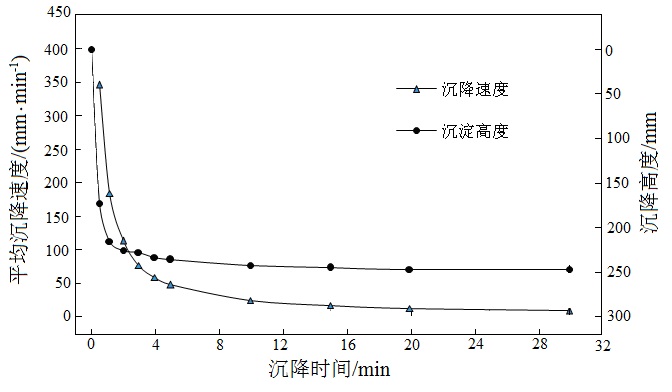
The data in Fig. 4 show that the solid-phase settling rate is very fast after adding flocculant and mixing sufficiently. The maximum free settling rate of nickel and cobalt precipitation is 345 mm/min, and the average free settling rate is 180 mm/min. 1 min or so solid-phase settling is completed, and the slurry enters the compactionAbstract: Nickel and cobalt were selectively precipitated and enriched from Mn, Mg containing sulfate medium with active magnesium oxide. The results show that the optimum precipitation conditions include twice of theoretical dosage of active magnesium oxide, reaction time of 6 h, and precipitation temperature of 25 ℃. The precipitation rate of nickel and cobalt is 97.96% and 96.43% respectively. The content of nickel, cobalt, manganese and magnesium oxide in precipitate is 8.51%, 13.05%, 2.29%, and 4.97% respectively. The average static-state free settling velocity of slurry is 180 mm/min with the dosage of flocculant AN905 of 0.2 g/m3.
3 Conclusion
(1) active magnesium oxide from the sulfate medium containing manganese, magnesium selective precipitation enrichment of nickel, cobalt, the best conditions are: after slurrying to add 2 times the theoretical amount of active magnesium oxide, reaction residence time 6 h, precipitation temperature 25 ℃. Under this condition, the precipitation rate of nickel and cobalt liquid meter was 97.96% and 96.43% respectively, and the content of nickel, cobalt, manganese and magnesium oxide in the precipitate was 8.51%, 13.05%, 2.29% and 4.97% respectively.
(2) After adding 0.2 g of AN905 flocculant per cubic meter of nickel and cobalt precipitation slurry, the maximum free settling velocity of nickel and cobalt precipitation was 345 mm/min, and the average free settling velocity was 180 mm/min, the solid phase settling velocity was fast, which was favorable for the subsequent liquid-solid separation.

